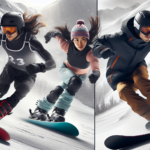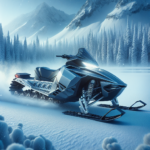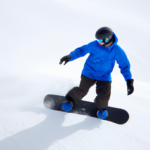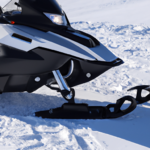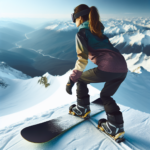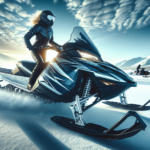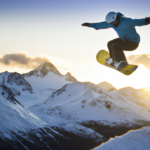You’ve found yourself standing at the peak of a snow kissed mountain, the cold air rushing past you with a promise of speed and thrill. Suddenly, you’re faced with the million-dollar decision: snowboarding or skiing? This article will guide you through the pros and cons of each sport, their unique features, benefits and challenges to help you make that choice. By examining factors like ease of learning, safety, movement, and fun, we aim to help you determine which ride down the mountain suits you best. So, get ready, because it’s time to unlock this frosty face-off between snowboarding and skiing.
Definition of Snowboarding
Snowboarding is a winter sport that involves descending a slope covered in snow, using a board that’s attached to a rider’s feet. The thrill of snowboarding lies in the rider’s ability to perform various tricks and manoeuvres, not unlike those of a skateboarder or surfer.
Detailed explanation of snowboarding
The snowboarding experience is determined by the shape and type of the board, the snow conditions, and the rider’s skill and preferences. Snowboarding typically involves carving, jumping, freeriding, jigging, free-styling and rail-riding. Unlike skiing, where the rider faces forward, snowboarding is done in a sideways stance, which allows for unique dynamics.
History of snowboarding
The history of snowboarding is filled with innovation and ingenuity. The sport originated in the USA in the 1960s and 70s, inspired by skateboarding, surfing and sledding traditions. The “snurfer” (snow surfer), invented by Sherman Poppen, is widely regarded as the first snowboard. This sparked a new wave of snow sports that quickly spread globally, and snowboarding became a Winter Olympic sport in 1998.
Types of snowboarding styles
Snowboarding styles vary greatly and heavily depend on the type of terrain. Some popular ones are freestyle, freeride, alpine and boardercross. Freestyle focuses on tricks, jumps and rail sliding, while freeride is about enjoying natural terrain, off-piste slopes and deep snow. Alpine style emphasizes carving turns on groomed runs, and boardercross involves racing other riders down a course.
Definition of Skiing
Skiing, one of the oldest types of transport, is a sport that involves sliding over snow with skis attached to each foot. Today, skiing is a popular winter sport that offers a unique combination of speed, precision, and adventure.
Detailed explanation of skiing
Skiing can be done in various styles and events, mostly involving more straight-on leg position, compared to the sideways stance of snowboarding. Skiers can navigate flat terrain, uphill slopes, and downhill descents. Skiing primarily involves two styles: Alpine (downhill) skiing and Nordic (cross-country) skiing.
History of skiing
Skiing has a storied history tracing back to ancient times. Cave drawings suggest that man used skis during the last Ice Age in the Palaeolithic period. Originally a method of transport, skiing evolved into a popular recreational activity by the mid-19th century and featured in the first Winter Olympics in 1924.
Types of skiing styles
Just like snowboarding, skiing has diverse styles. The most common are alpine, freestyle, touring, cross-country and Telemark skiing. Alpine skiing is the most popular style practiced at resorts and ski areas and involves downhill skiing on groomed runs. Freestyle focuses on tricks like jumps, halfpipes and moguls. Touring is about adventuring into the backcountry, while cross-country is considered the original form of skiing.
Factors to Consider When Choosing Between Skiing and Snowboarding
Choosing between skiing and snowboarding depends on different factors. Let’s delve into some of the main ones.
Level of difficulty
Like any sport, both skiing and snowboarding come with their own set of challenges. Typically, skiing is easier to pick up at first but harder to master, while snowboarding might be trickier to get the hang of initially but easier to progress in the long run.
Physical fitness requirement
Both skiing and snowboarding require physical fitness but focus on different muscle groups. Skiing uses more lower body strength and core stability, while snowboarding relies heavily on your core and leg strength for balance and control.
Equipment cost
The equipment cost for both sports can vary greatly, depending on the gear’s brand, quality, and latest technology. Generally speaking, skiing equipment tends to be slightly more expensive than snowboarding.
Training/lessons cost
The cost of lessons for beginners can be a factor. Usually, the cost of snowboarding and skiing lessons are similar, but the number of necessary classes before you become proficient could be higher for snowboarding.
Health Benefits of Snowboarding
Snowboarding isn’t just about thrills and tricks; it also comes with numerous health benefits.
Fitness benefits
Snowboarding is a great way to improve your balance, flexibility, and endurance. It is a full-body workout, and it can help increase your core strength and burn calories.
Mental health benefits
The mental health benefits of snowboarding are profound. The sport offers stress relief and improves your mood, focus, and confidence.
Heart health benefits
Snowboarding increases your heart rate, making it an excellent cardiovascular activity. It can help lower the risk of heart diseases and improve your heart health in the long term.
Health Benefits of Skiing
Just like snowboarding, skiing has its share of health benefits.
Fitness benefits
Skiing is an excellent way to get active and fit. It strengthens your lower body muscles, enhances your flexibility and agility, and improves your proprioceptive abilities.
Mental health benefits
Skiing can be beneficial for your mental health. The fresh mountain air, breathtaking vistas, and the sheer pleasure of sliding over snow can make you feel happier, reduce anxiety, and improve your overall well-being.
Heart health benefits
Skiing is a fantastic cardiovascular workout that can benefit your heart health by boosting your cardiovascular endurance and reducing the risk of heart diseases.
Snowboarding vs Skiing: Learning Curve and Speed of Progression
In terms of how quickly you can learn both sports, it varies.
How quickly you can learn snowboarding
Generally, it takes longer to learn snowboarding. The first few days can be challenging as you learn how to balance, turn and stop. But once you master these basic skills, progression is often rapid.
How quickly you can learn Skiing
Skiing generally allows for quick early stage progress. You can usually start moving around on skis and navigating gentle slopes sooner than on a snowboard. However, mastering more complex techniques may take more time.
Comparison of both learning curves
Though it’s often said that skiing is easier to start and harder to master while snowboarding is harder in the beginning but easier to progress, these are just general observations. The reality is that individual experiences may vary greatly based on athleticism, fear factor, and the quality of instruction received.
Gears and Equipment: Snowboarding vs Skiing
Choosing the right equipment is essential for a great experience on the slopes, whether you choose to ski or snowboard.
Equipment needed for skiing
For skiing, you’ll need skis, ski boots, bindings, poles, a helmet, and ski-specific clothing to keep you warm and dry in various weather conditions.
Equipment needed for snowboarding
Snowboarding requires a snowboard, boots, bindings, snowboard specific outerwear, and a helmet.
Cost comparison
Ski gear can often be a bit more costly than snowboarding equipment, mainly because skis and ski boots tend to be more technologically advanced and hence more expensive. Nevertheless, the costs can vary widely based on factors like brand, quality, and where you’re shopping.
Maintenance and longevity
Maintenance costs for both activities can also add up, though if well cared for, skiing and snowboarding equipment can last for years before needing to be replaced.
Popularity and Culture: Snowboarding vs Skiing
The culture around both sports is vibrant and adds to the overall experience.
Global popularity of snowboarding
Over the past few decades, snowboarding has seen a massive increase in popularity, particularly amongst the younger generations. The freestyle nature of the sport and its close ties with skateboarding and surfing culture make it an attractive choice for many.
Global popularity of skiing
Skiing, however, remains the more globally popular of the two by a significant margin. Its deep-rooted history, the appeal to a broader age-range, and the variety of styles and disciplines contribute to its widespread popularity.
Influence of culture on preference
Depending mostly on your recreational preferences, snowboarding might appeal to those who love its more laid-back culture and are attracted to the freestyle approach. In contrast, skiing tends to attract those who appreciate its tradition, sophistication, and versatility.
Snowboarding vs Skiing: Injury Risks
As winter sports, both skiing and snowboarding come with their share of risks, yet the nature of injuries varies.
Common injuries in snowboarding
Snowboarding carries a higher risk of wrist, shoulder, and ankle injuries. This is due in part to falling backward or forwards while balancing on a single board, leading to overextended arms and potential joint injuries.
Common injuries in skiing
Skiing, on the other hand, is associated with injuries to the knees and lower extremities due to the legs being separated and the twisting movements that are a critical part of the technique.
Safety precautions to take
Regardless of your choice between skiing and snowboarding, it’s essential to wear the right protective gear, warm-up before participating, follow proper procedures, and pace yourself according to your skill level.
FAQs About Skiing and Snowboarding
Finally, let’s address some common questions you might have about skiing and snowboarding.
What is harder Skiing or Snowboarding?
As noted earlier, skiing tends to be easier to start but harder to master, while snowboarding might feel more challenging at first but is often easier to progress in once the basics are nailed.
Which is more dangerous Skiing or Snowboarding?
Both skiing and snowboarding come with risks and the potential for injury, but studies have shown that snowboarders tend to have more wrist injuries, while skiers tend to have more knee injuries.
Which is more fun Skiing or Snowboarding?
The “fun” factor is incredibly subjective. Some people prefer the rush of skiing, while others appreciate the freestyle nature and challenging balance adjustments in snowboarding.
Is it possible to do both skiing and snowboarding?
Absolutely! Plenty of people enjoy both sports. Having skills in both can make you a more versatile winter sports enthusiast and open up new ways to enjoy the slopes.
- What Snowboard Bindings Should I Get? - January 23, 2024
- What Size Screws For Snowboard Bindings? - January 23, 2024
- How To Snowmobile On Water? - January 23, 2024




